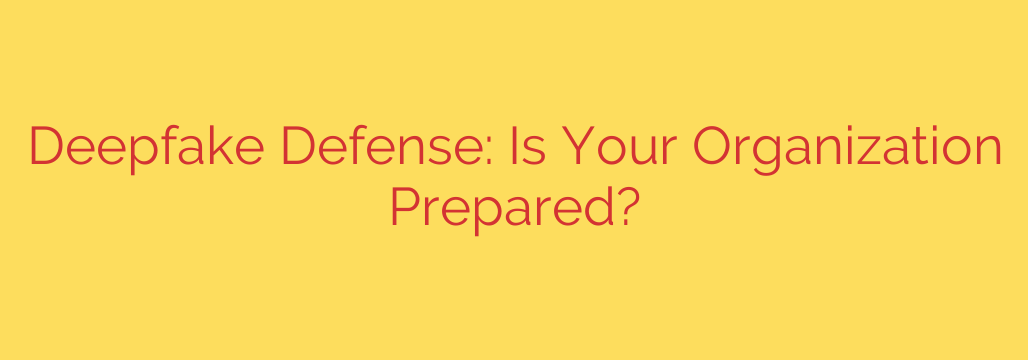
The New Face of Corporate Fraud: Is Your Business Ready for Deepfake Threats?
What was once the realm of science fiction is now a stark reality for businesses worldwide. We’re talking about deepfakes—highly realistic, AI-generated videos and audio clips that can convincingly mimic anyone, from a celebrity to your company’s CEO. While the technology has creative applications, it has also opened a new, sophisticated frontier for cybercriminals. The question is no longer if deepfakes will be used to target organizations, but how and when.
The threat is real and growing. Criminals are leveraging synthetic media to bypass traditional security measures, manipulating employees into making catastrophic errors. Understanding this threat is the first critical step toward building a robust defense.
The Alarming Rise of Deepfake-Powered Attacks
Deepfakes are the ultimate tool for social engineering. By creating convincing audio or video, attackers can impersonate trusted figures to deceive employees, partners, and clients. These attacks are not theoretical; they are happening now and costing companies millions.
Here are the primary ways deepfakes are weaponized against businesses:
- CEO Fraud and Voice “Vishing”: This is one of the most common and damaging attacks. A criminal uses voice-cloning technology to call an employee in the finance department, perfectly mimicking the CEO’s voice. The “CEO” then creates a sense of urgency—claiming a secret acquisition or a time-sensitive payment is needed—and instructs the employee to wire a large sum of money to a fraudulent account. Because the voice sounds authentic, standard suspicion is often bypassed.
- Sophisticated Phishing and Impersonation: Traditional phishing emails are becoming easier to spot. However, a deepfake can elevate the scam. Imagine receiving an email from a key partner, followed by a brief video call where the “partner” confirms a change in payment details. The visual confirmation adds a powerful layer of legitimacy that can fool even cautious employees.
- Reputation Sabotage and Market Manipulation: Malicious actors can create a deepfake video of an executive making inflammatory statements, admitting to fraud, or announcing false, damaging news. This content can be released online to tank a company’s stock price, destroy its public reputation, or sow internal chaos.
Building Your Deepfake Defense: A Proactive, Multi-Layered Strategy
Reacting to a deepfake attack after the fact is too late. The key to protection is a proactive and multi-layered defense that combines technology, process, and human awareness. Your organization cannot afford to be unprepared.
Here are essential, actionable steps to protect your business:
1. Foster a Culture of Healthy Skepticism
Your employees are your first and most important line of defense. It’s crucial to conduct ongoing training that specifically addresses deepfake threats.
- Educate everyone: From the C-suite to new hires, ensure all staff understand what deepfakes are and how they are used in corporate attacks.
- Highlight the “urgency” red flag: Train employees to be extra cautious of any unusual, urgent request, especially one involving financial transactions or sensitive data, regardless of who it appears to come from.
2. Implement Ironclad Verification Protocols
Technology can be fooled, but a strong process is much harder to break. The single most effective defense against deepfake-driven fraud is out-of-band verification.
- Mandate secondary confirmation: For any request to transfer funds, change payment information, or share sensitive data, require verification through a separate, pre-established communication channel. If the request comes via email, confirm it with a phone call to a known number (not one provided in the email). If it comes via a phone call, confirm it with a message on an internal platform like Slack or Teams.
- Use code words: For highly sensitive operations, consider establishing a simple verbal password or code word between key personnel (e.g., the CEO and CFO) to be used during live conversations to confirm identity.
3. Strengthen Your Technical Security Stack
While no single tool is a silver bullet, technology can help flag suspicious activity.
- Deploy Multi-Factor Authentication (MFA): Ensure MFA is active on all critical accounts, including email, banking, and internal communication systems. This makes it much harder for an attacker to gain initial access.
- Advanced Email Security: Use email filters that can detect signs of impersonation, suspicious links, and spoofed domains.
- Consider Detection Tools: Emerging technologies offer deepfake detection capabilities. While still evolving, these tools can analyze video for subtle artifacts and audio for signs of synthesis, providing an additional layer of security.
4. Develop a Clear Incident Response Plan
Know exactly what to do if you suspect a deepfake attack is underway.
- Establish a clear reporting chain: Who should an employee contact immediately if they receive a suspicious request?
- Have a containment plan: How will you secure accounts, halt transactions, and communicate internally to prevent further damage?
- Involve digital forensics: Have experts ready to analyze the evidence, trace the attack, and help you recover.
As AI technology becomes more accessible, the creation of convincing deepfakes will only get easier and cheaper. The threat to your organization’s finances, data, and reputation is undeniable. By treating deepfakes as a serious cybersecurity risk and implementing a robust, multi-layered defense, you can empower your team to recognize the deception and protect your business from this insidious new form of fraud.
Source: https://www.tripwire.com/state-of-security/does-your-organization-need-deepfake-defenses








